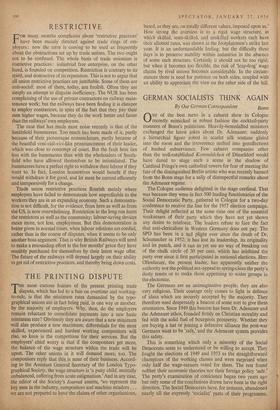THE PRINTING DISPUTE
T1413 most curious feature of the present printing trade dispute, which has led to a ban on overtime and working- to-rule, is that the minimum rates demanded by the typo- graphical unions are in fact being paid, in one way or another, by the majority of employers. Why, then, do the employers remain reluctant to consolidate payments into a new basic minimum rate? Obviously they are aware that a new minimum will also produce a new maximum; differentials for the most skilled, experienced and hardest working compositors will rise, so keen is the competition for their services. But the employers' chief worry is that if the compositors get more, the balance of the wage structure within the trade will be upset. The other unions in it will demand more, too. The compositors reply that this is none of their business. Accord- ing to the Assistant General Secretary of the London Typo- graphical Society, the wage structure is 'a puny child, mentally unbalanced, suffering from acute astigmatism.' And in any case, the editor of the Society's Journal asserts, 'we represent the key men in the industry, compositors and machine minders . we are not prepared to have the claims of other organisations, based, as they are, on totally different values, imposed upon us.' How Strong the aversion is to a rigid wage structure, in which skilled, semi-skilled, and unskilled workers each have their allotted rates, was shown in the fOotplatemen's strike last year. It is an understandable feeling; but the difficulty these days is to preserve stability within industries in the absence of some such structure. Certainly it should not be too rigid; but when it becomes too flexible, the risk of 'leap-frog' wage claims by rival unions becomes considerable. In the circum- stances there is need for patience on both sides, coupled with an ability to appreciate the view on the other side of the hill.










































 Previous page
Previous page